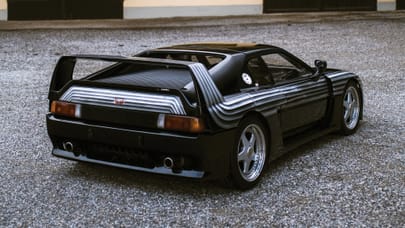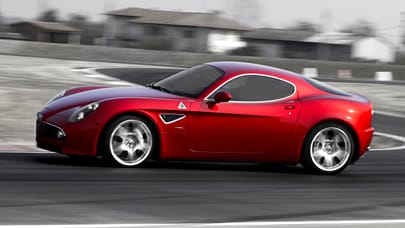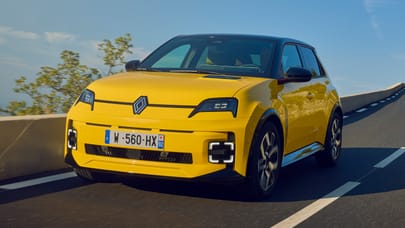
Top Gear’s Top 9: racing cars that, er, didn’t race
TG’s guide to the coolest ill-fated racers that never took to a track in anger

Ferrari F50 GT

Imagine an ‘F50 XX Evo’ if you will. Fixed roof, gnarly aero, slick tyres and a V12 juiced up from 520bhp to 740bhp. The final boss evolution of Ferrari’s ultimate supercar for the Nineties.
It very nearly happened, deafening grandstands across the continent. But dismayed at Porsche’s rule-bending 911 GT1 homologation special, Ferrari canned its GT1 project after only three cars were completed, never to see competition.
Advertisement - Page continues belowAlfa Romeo 164 Procar

An intended replacement for F1’s BMW M1 ProCar sideshow, Formula S should’ve been legend. Outrageous silhouette racers shoved F1 engines into the footprint of a humdrum family saloon.
Somehow, only Alfa Romeo was organised enough to build a 600bhp, 750kg prototype, and after its easy-going demo runs failed to impress, one Bernie Ecclestone snuffed out Formula S.
Porsche LMP2000

A real enigma of a tale, this: Porsche plotted a Le Mans winner for the new millennium using a mothballed V10 originally plotted for the 1992 Footwork F1 team. However, the car never raced.
Some say its death freed up company funds for the crucial Cayenne SUV. Others insist Porsche was stepping aside to pave the way for fellow VW Group member Audi’s 24hrs dominance. All we know is that howling V10 later found a glorious home in the Carrera GT supercar. Not a complete waste, then.
Advertisement - Page continues belowJaguar XJ13

One for superstitious readers to ponder, the XJ13 was Jaguar’s mid-engined V12 prototype racer for the 1960s, but despite being conceived in the late 1950s the car wasn’t built and running until 1966.
By then the Ford GT was on the scene, so despite promising testing the XJ13 was getting on a bit, tech-wise.
It was crashed in 1971 by Jag’s test driver Norman Dewis, but has fortunately since been restored and preserved, though it never saw a chequered flag.
Lancia ECV

What’s potentially better than a Group B rally car? A Group S rally car, that’s what.
The likes of Toyota, Ford and Lancia all drew up plans for cars to comply with Group S regs in the mid 1980s, with Lancia’s Experimental Composite Vehicle teaming space-age carbon compete bodywork with a 600bhp engine (set to be limited to 300bhp for safer competition).
However, Group B’s fatal safety record meant it – and Group S – were cancelled for 1987, so the next-gen cars were denied their chance to continue the bonkers legacy.
Ferrari GTO Evoluzione

Most car geeks know that the ‘O’ in GTO stands for ‘omologato’. What you might not know is that this brutal-looking monster was what the Ferrari 288 GTO ‘omolgated’ for the road.
A fusion of 288, F40 and F1, five examples of the 650bhp special were built before the cessation of Group B regs (for sportscars as well as rallying) left the GTO high and dry, fated to have prancing horse collectors squabbling over them the decades to follow.
Toyota 222D

Another Group S rallying orphan, Toyota’s skunkworks 222D demonstrates the dizzying lengths manufacturers were going to in creating the ultimate rally machine.
In essence, it was a gen1 MR2, stripped to a Lotus Elise-like 750kg, with 650bhp. And adaptive all-wheel drive.
Three still exist, of which one is a runner – with a titanic three seconds of turbo lag between pushing the gas and getting the boost.
Those were the days.
Advertisement - Page continues belowKoenigsegg CCGT

Christian von Koenigsegg designed the CC supercar with Le Mans regs in mind. A prototype was built. It weighed under a tonne, developed 600bhp, 600kg of downforce, and testing was proving extremely promising.
Then the GT1 rules were rewritten to ban carbon tubbed cars. Oh, and 350 homologation road cars has to be built, instead of just 20. That was the end of Koenigsegg’s motorsport ambitions.
Still, they’ve done reasonably well with the road-based stuff since…
Lamborghini Diablo GT1

Despite inventing the mid-engined supercar and being no stranger to a huge rear wing, Lamborghini has never commanded the same sort of motorsport pedigree reputation as Ferrari, Porsche or Ford.
In the mid-Nineties, it decided to rectify this by barging into GT1 racing and duffing up the McLaren F1 GTR, Porsche 911 and anyone else that came near its 655bhp longtail V12 Diablo.
Two road-going versions were built before the top brass looked at the company coffers and decided it had better concentrate on selling road cars if it wanted to keep the lights on.
Advertisement - Page continues below
Trending this week
- Car Review
MG Motor UK IM6
- Long Term Review
Life with a Volvo EX30: the machine is always WATCHING YOU







